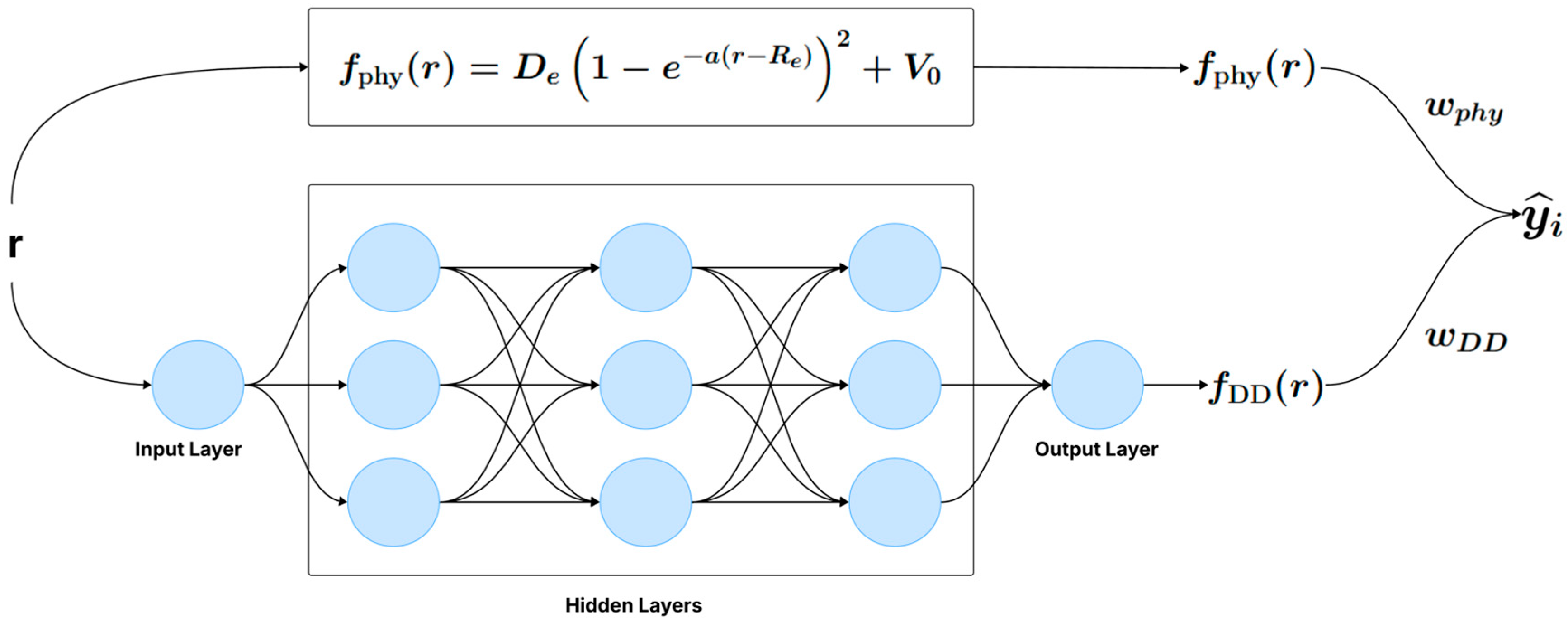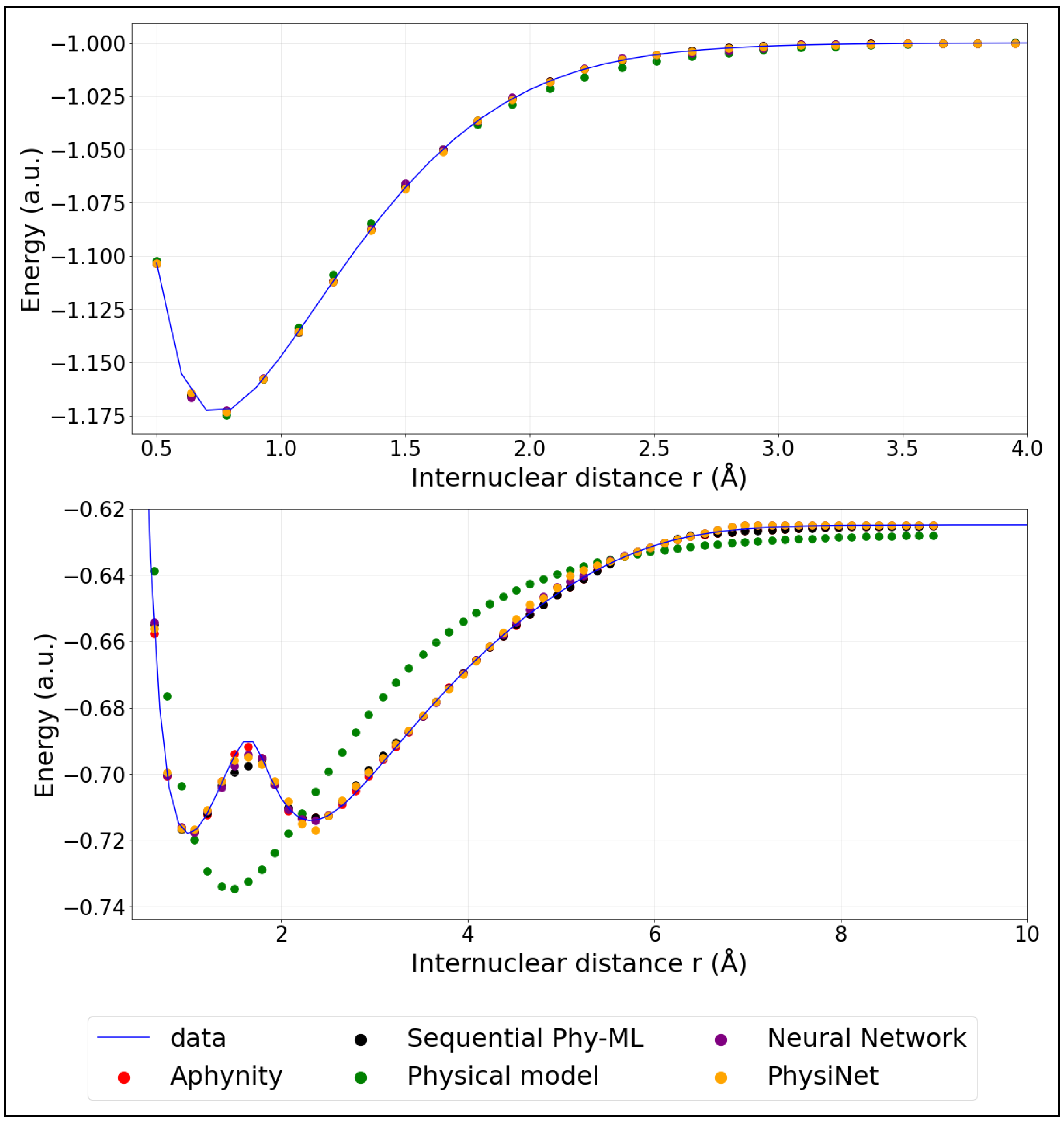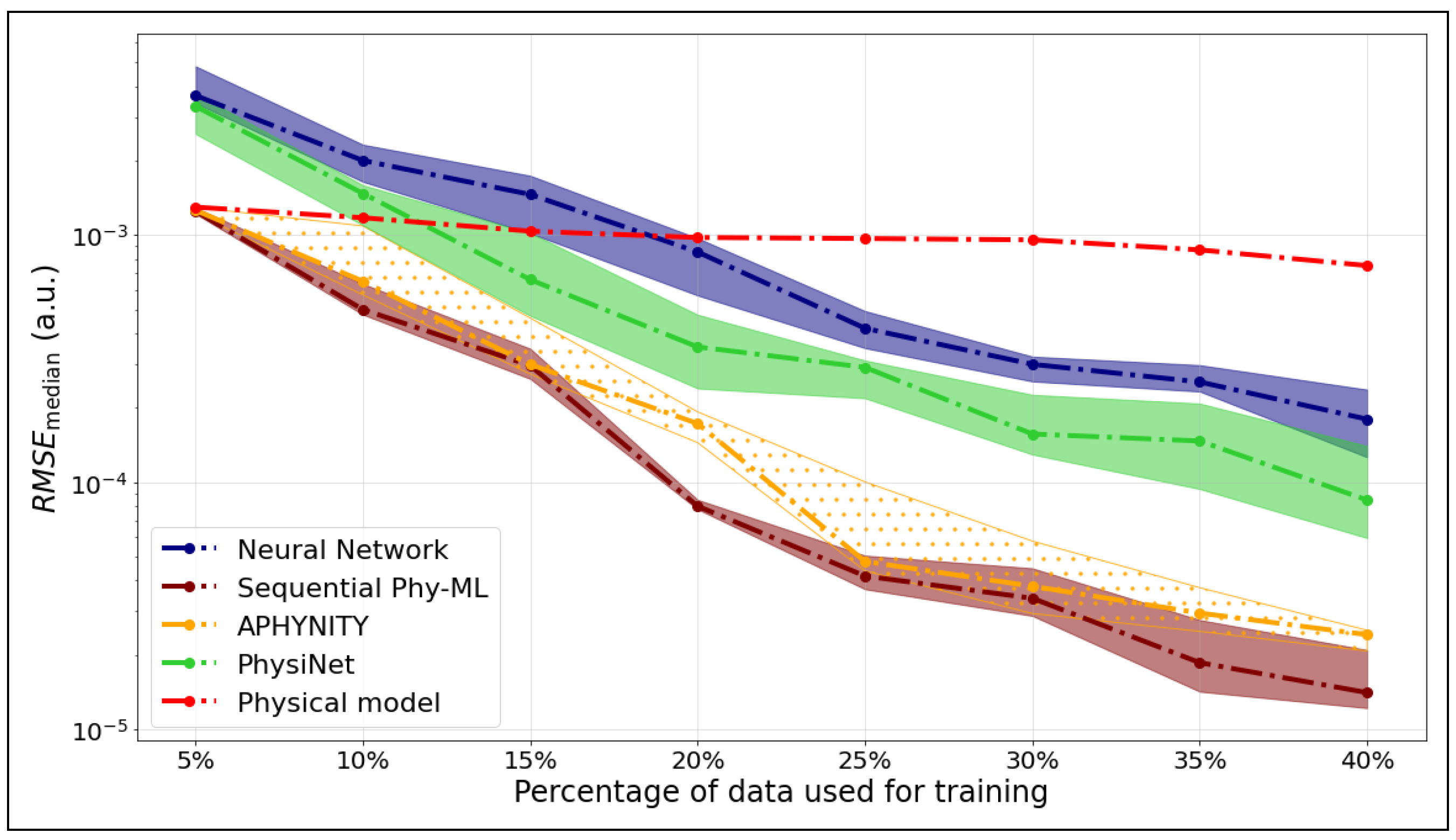Combining Physics and Machine Learning: Hybrid Models for Predicting Interatomic Potentials
Abstract
1. Introduction
2. Methodology
2.1. Decomposition into Physics-Based and Data-Driven Terms
2.2. Training, Hybrid Models, and Parametrization
2.2.1. Training
| Algorithm 1 Training of the one-step models |
|
| Algorithm 2 Training of the two-step model |
|
2.2.2. One-Step Models
2.2.3. Two-Step Model
3. Evaluation
3.1. Root Mean Square Error
3.2. Franck–Condon Factors
4. Results
4.1. Evaluation Using RMSE on the Testing Set
4.2. Evaluation Using on the Test Set
4.3. Comparison of the Obtained Physical Parameters
5. Conclusions
- When only a limited amount of data is available, hybrid models outperform purely neural network approaches, thanks to the structural guidance provided by the physical model. However, in cases where the physical model is not very informative, hybrid models only become competitive once a sufficient volume of data is provided.
- The use of Franck–Condon factors as an evaluation criterion confirmed that hybrid models, particularly APHYNITY and Sequential Phy-ML, produce curves that are more physically consistent than those generated by neural networks.
Author Contributions
Funding
Institutional Review Board Statement
Informed Consent Statement
Data Availability Statement
Acknowledgments
Conflicts of Interest
Appendix A
| Training Data Size | Learning Rate | Penalty Factor | Number of Epochs |
|---|---|---|---|
| 5% | 0.0015 | 2 | 500,000 |
| 10% | 0.00098 | 6 | 500,000 |
| 15% | 0.001 | 6 | 500,000 |
| 20% | 0.00098 | 6 | 500,000 |
| 25% | 0.0007 | 3 | 1,200,000 |
| 30% | 0.0007 | 3 | 1,200,000 |
| 35% | 0.0007 | 3 | 1,200,000 |
| 40% | 0.0007 | 4 | 1,400,000 |
| Training Data Size | Learning Rate | Penalty Factor | Number of Epochs |
|---|---|---|---|
| 5% | 0.001 | 1 | 200,000 |
| 10% | 0.00098 | 6 | 200,000 |
| 15% | 0.00098 | 6 | 400,000 |
| 20% | 0.0009 | 6 | 400,000 |
| 25% | 0.0006 | 6 | 700,000 |
| 30% | 0.0006 | 6 | 700,000 |
| 35% | 0.00062 | 6 | 700,000 |
| 40% | 0.0007 | 4 | 900,000 |
| Training Data Size | Learning Rate | Number of Epochs |
|---|---|---|
| 5% | 0.00001 | 200,000 |
| 10% | 0.00001 | 200,000 |
| 15% | 0.00001 | 400,000 |
| 20% | 0.00001 | 400,000 |
| 25% | 0.000009 | 900,000 |
| 30% | 0.000009 | 900,000 |
| 35% | 0.000009 | 900,000 |
| 40% | 0.000009 | 900,000 |
| Training Data Size | Learning Rate | Number of Epochs |
|---|---|---|
| 5% | 0.00001 | 900,000 |
| 10% | 0.00001 | 900,000 |
| 15% | 0.00001 | 900,000 |
| 20% | 0.00001 | 900,000 |
| 25% | 0.000009 | 1,400,000 |
| 30% | 0.000009 | 1,400,000 |
| 35% | 0.000009 | 1,400,000 |
| 40% | 0.000009 | 1,400,000 |
| Training Data Size | Learning Rate | Number of Epochs |
|---|---|---|
| All size | 0.01 | 100,000 |
| All size | 0.0005 | 900,000 |
| Training Data Size | Learning Rate | Number of Epochs |
|---|---|---|
| All size | 0.01 | 100,000 |
| 5% to 20% | 0.001 | 100,000 |
| 20% to 40% | 0.00092 | 400,000 |
Appendix B

| 1 | Available online: https://github.com/Kaoutar142/Combining-Physics-and-ML-for-predicting-interatomic-potentials.git (accessed on 13 October 2025). |
| 2 | corresponds to the RMSE for which 50% of the training runs yield an error that is less than or equal to it, while the other 50% yield an error that is greater than or equal to it. This measure provides a more representative evaluation of the model’s overall performance across all trials. |
| 3 | The first quartile corresponds to the RMSE value below which 25% of the training runs fall. In other words, 25% of the RMSE values are less than or equal to this value, while 75% are greater. |
| 4 | The third quartile corresponds to the RMSE value below which 75% of the training runs fall. That is, 75% of the RMSE values are less than or equal to this value, while 25% are greater. |
References
- Ramakrishnan, R.; Hartmann, M.; Tapavicza, E.; von Lilienfeld, O.A. Electronic spectra from TDDFT and machine learning in chemical space. J. Chem. Phys. 2015, 143, 084111. [Google Scholar] [CrossRef]
- Pronobis, W.; Schütt, K.T.; Tkatchenko, A.; Müller, K.-R. Capturing intensive and extensive DFT/TDDFT molecular properties with machine learning. Eur. Phys. J. 2018, 91, 178. [Google Scholar] [CrossRef]
- Roy, R.L.; Henderson, R.D.E. A new potential function form incorporating extended long-range behaviour: Application to ground-state Ca2. Mol. Phys. 2018, 105, 663–677. [Google Scholar] [CrossRef]
- Roy, R.L.; Haugen, C.C.; Tao, J.; Li, H. Long-range damping functions improve the short-range behaviour of ’MLR’ potential energy functions. Mol. Phys. 2011, 109, 435–446. [Google Scholar] [CrossRef]
- Zhai, Y.; Li, H.; Roy, R.L. Constructing high-accuracy intermolecular potential energy surface with multi-dimension Morse/Long-Range model. Mol. Phys. 2018, 116, 843–853. [Google Scholar] [CrossRef]
- Behler, J. Neural network potential-energy surfaces in chemistry: A tool for large-scale simulations. Phys. Chem. Chem. Phys. 2011, 13, 17930–17955. [Google Scholar] [CrossRef]
- Hornik, K.; Stinchcombe, M.; White, H. Multilayer feedforward networks are universal approximators. Neural Netw. 1989, 2, 359–366. [Google Scholar] [CrossRef]
- Barron, A.R. Universal Approximation Bounds for Superpositions of a Sigmoidal Function. IEEE Trans. Inf. Theory 1993, 39, 930. [Google Scholar] [CrossRef]
- Manzhos, S.; Carrington, T., Jr. Neural Network Potential Energy Surfaces for Small Molecules and Reactions. Phys. Chem. Chem. Phys. 2021, 121, 10187–10217. [Google Scholar] [CrossRef]
- Dral, P.O. Quantum Chemistry in the Age of Machine Learning. J. Phys. Chem. Lett. 2020, 11, 2336–2347. [Google Scholar] [CrossRef]
- Jiang, B.; Li, J.; Guo, H. High-Fidelity Potential Energy Surfaces for Gas-Phase and Gas–Surface Scattering Processes from Machine Learning. J. Phys. Chem. Lett. 2020, 13, 5120–5131. [Google Scholar] [CrossRef]
- Meuwly, M. Machine Learning for Chemical Reactions. Chem. Rev. 2021, 121, 10218–10239. [Google Scholar] [CrossRef]
- Deringer, V.L.; Bartók, A.P.; Bernstein, N.; Wilkins, D.M.; Ceriotti, M.; Csányi, G. Gaussian Process Regression for Materials and Molecules. Chem. Rev. 2021, 121, 10187–10217. [Google Scholar] [CrossRef]
- Ye, S.; Hu, W.; Li, X.; Zhang, J.; Zhong, K.; Zhang, G.; Luo, Y.; Mukamel, S.; Jiang, J. A neural network protocol for electronic excitations of N-methylacetamide. Natl. Libr. Med. 2019, 116, 11612–11617. [Google Scholar] [CrossRef] [PubMed]
- Chen, W.K.; Liu, X.Y.; Fang, W.H.; Dral, P.O.; Cui, G. Deep Learning for Nonadiabatic Excited-State Dynamics. J. Phys. Chem. Lett. 2018, 9, 6702–6708. [Google Scholar] [CrossRef] [PubMed]
- Dral, P.O.; Barbatti, M.; Thiel, W. Nonadiabatic Excited-State Dynamics with Machine Learning. J. Phys. Chem. Lett. 2018, 9, 5660–5663. [Google Scholar] [CrossRef] [PubMed]
- Hu, D.; Xie, Y.; Li, X.; Li, L.; Lan, Z. Inclusion of Machine Learning Kernel Ridge Regression Potential Energy Surfaces in On-the-Fly Nonadiabatic Molecular Dynamics Simulation. J. Phys. Chem. Lett. 2018, 9, 2725–2732. [Google Scholar] [CrossRef]
- Westermayr, J.; Gastegger, M.; Menger, M.F.S.J.; Mai, S.; González, L.; Marquetand, P. Machine learning enables long time scale molecular photodynamics simulations. Chem. Sci. 2019, 10, 8100–8107. [Google Scholar] [CrossRef]
- Dral, P.O.; Barbatti, M. Molecular excited states through a machine learning lens. Nat. Rev. Chem. 2021, 5, 388–405. [Google Scholar] [CrossRef]
- Westermayr, J.; Marquetand, P. Deep learning for UV absorption spectra with SchNarc: First steps toward transferability in chemical compound space. J. Chem. Phys. 2020, 153, 154112. [Google Scholar] [CrossRef]
- Westermayr, J.; Faber, F.A.; Christensen, A.S.; von Lilienfeld, O.A.; Marquetand, P. Neural networks and kernel ridge regression for excited states dynamics of CH2NH2: From single-state to multi-state representations and multi-property machine learning models. Mach. Learn. Sci. Technol. 2020, 1, 025009. [Google Scholar] [CrossRef]
- Li, A.; Guo, H. A full-dimensional global potential energy surface of H3O+(ã3A) for the OH+(3Σ−) + H2(1Σg+) → H(2S) + H2O+(2B1) reaction. J. Phys. Chem. A 2014, 118, 11168–11176. [Google Scholar] [CrossRef]
- Stoppelman, J.P.; McDaniel, J.G. Physics-based, neural network force fields for reactive molecular dynamics: Investigation of carbene formation from [EMIM+][OAc−]. Chem. Phys. 2021, 155, 104112. [Google Scholar] [CrossRef]
- Bereau, T.; DiStasio, R.A., Jr.; Tkatchenko, A.; von Lilienfeld, O.A. Non-covalent interactions across organic and biological subsets of chemical space: Physics-based potentials parametrized from machine learning. Chem. Phys. 2018, 148, 241706. [Google Scholar] [CrossRef]
- Konrad, M.; Wenzel, W. CONI-Net: Machine Learning of Separable Intermolecular Force Fields. J. Chem. Theory Comput. 2021, 17, 4996–5006. [Google Scholar] [CrossRef]
- Ramakrishnan, R.; Dral, P.O.; Rupp, M.; von Lilienfeld, O.A. Big Data Meets Quantum Chemistry Approximations: The Δ-Machine Learning Approach. J. Chem. Theory Comput. 2015, 11, 2087–2096. [Google Scholar] [CrossRef]
- Westermayr, J.; Gastegger, M.; Schütt, K.T.; Maurer, R.J. Perspective on integrating machine learning into computational chemistry and materials science. J. Chem. Phys. 2021, 154, 230903. [Google Scholar] [CrossRef]
- Li, S.; Xie, B.B.; Yin, B.W.; Liu, L.; Shen, L.; Fang, W.H. Construction of Highly Accurate Machine Learning Potential Energy Surfaces for Excited-State Dynamics Simulations Based on Low-Level Data Sets. J. Phys. Chem. A 2024, 128, 5516–5524. [Google Scholar] [CrossRef]
- Yin, Y.; Guen, V.L.; Dona, J.; de Bézenac, E.; Ayed, I.; Thome, N.; Gallinari, P. Augmenting Physical Models with Deep Networks for Complex Dynamics Forecasting. J. Stat. Mech. Theory Exp. 2021, 2021, 124012. [Google Scholar] [CrossRef]
- Sun, C.; Shi, V.G. PhysiNet: A Combination of Physics-based Model and Neural Network Model for Digital Twins. Int. J. Intell. Syst. 2021, 37, 5443–5456. [Google Scholar] [CrossRef]
- Schmidt, M.W.; Baldridge, K.K.; Boatz, J.A.; Elbert, S.T.; Gordon, M.S.; Jensen, J.H.; Koseki, S.; Matsunaga, N.; Nguyen, K.A.; Su, S.; et al. General atomic and molecular electronic structure system. J. Comput. Chem. 1993, 14, 1347–1363. [Google Scholar] [CrossRef]
- Dunning, T.H. Gaussian basis sets for use in correlated molecular calculations. I. The atoms boron through neon and hydrogen. J. Chem. Phys. 1989, 90, 1007–1023. [Google Scholar] [CrossRef]
- Kendall, R.A.; Dunning, T.H.; Harrison, R.J. Electron affinities of the first-row atoms revisited. Systematic basis sets and wave functions. J. Chem. Phys. 1992, 96, 6796–6806. [Google Scholar] [CrossRef]






| Params | Training Data Size | Seed = 42 | Seed = 22 | Seed = 2 | ||||||
|---|---|---|---|---|---|---|---|---|---|---|
| APHYNITY | Sequential Phy-ML | Physi- Net | APHYNITY | Sequential Phy-ML | Physi- Net | APHYNITY | Sequential Phy-ML | Physi- Net | ||
| De | 5% | 0.0048 | 0.0049 | 3.8767 | 0.0048 | 0.0049 | 3.8833 | 0.0048 | 0.0049 | 3.8787 |
| Re | 5% | 0.0036 | 0.0035 | 0.0039 | 0.0036 | 0.0035 | 0.0299 | 0.0036 | 0.0035 | 0.0287 |
| a | 5% | 0.0032 | 0.0031 | 1.1708 | 0.0032 | 0.0031 | 0.5916 | 0.0033 | 0.0031 | 0.3554 |
| De | 10% | 0.0038 | 0.0036 | 3.8751 | 0.0038 | 0.0036 | 3.8954 | 0.0038 | 0.0051 | 3.8709 |
| Re | 10% | 0.0014 | 0.0012 | 0.0663 | 0.0013 | 0.0012 | 0.0488 | 0.0013 | 0.0035 | 0.037 |
| a | 5% | 0.0008 | 0.0013 | 0.094 | 0.0008 | 0.0013 | 0.3535 | 0.0007 | 0.0069 | 0.0235 |
| De | 15% | 0.0038 | 0.0039 | 3.8687 | 0.0038 | 0.0039 | 3.9119 | 0.0038 | 0.0039 | 3.8706 |
| Re | 15% | 0.0009 | 0.0008 | 0.0121 | 0.0009 | 0.0008 | 0.0779 | 0.0009 | 0.0008 | 0.0263 |
| a | 15% | 0.0041 | 0.004 | 0.7375 | 0.0041 | 0.004 | 0.3315 | 0.0041 | 0.004 | 1.1606 |
| De | 20% | 0.0039 | 0.0037 | 3.8597 | 0.0037 | 0.0037 | 3.9140 | 0.0037 | 0.0037 | 3.8907 |
| Re | 20% | 0.0024 | 0.0025 | 0.0400 | 0.0025 | 0.0025 | 0.0681 | 0.0024 | 0.0025 | 0.0268 |
| a | 20% | 0.0032 | 0.0003 | 0.6175 | 0.0004 | 0.0003 | 0.2672 | 0.0003 | 0.0003 | 0.0306 |
| De | 25% | 0.0037 | 0.0036 | 3.8811 | 0.0036 | 0.0036 | 3.8751 | 0.0036 | 0.0036 | 3.8811 |
| Re | 25% | 0.0039 | 0.0039 | 0.2081 | 0.0039 | 0.0039 | 0.0269 | 0.0039 | 0.0039 | 0.0452 |
| a | 25% | 0.0011 | 0.001 | 0.3395 | 0.001 | 0.001 | 0.1317 | 0.001 | 0.001 | 0.04 |
| De | 30% | 0.0040 | 0.0036 | 3.8760 | 0.0036 | 0.0036 | 3.8766 | 0.0036 | 0.0036 | 3.8811 |
| Re | 30% | 0.0046 | 0.0041 | 0.0725 | 0.0041 | 0.0041 | 0.0158 | 0.0041 | 0.0041 | 0.0475 |
| a | 30% | 0.0098 | 0.0017 | 0.0314 | 0.0018 | 0.0017 | 0.1552 | 0.0017 | 0.0017 | 0.0055 |
| De | 35% | 0.0034 | 0.0034 | 3.8779 | 0.0034 | 0.0034 | 3.8828 | 0.0034 | 0.0034 | 3.8817 |
| Re | 35% | 0.0036 | 0.0036 | 0.1894 | 0.0036 | 0.0036 | 0.0053 | 0.0037 | 0.0036 | 0.0513 |
| a | 35% | 0.0046 | 0.0046 | 0.0234 | 0.0046 | 0.0046 | 0.1934 | 0.0046 | 0.0046 | 0.0027 |
| De | 40% | 0.0031 | 0.0031 | 3.8765 | 0.0031 | 0.0031 | 3.8826 | 0.0031 | 0.0031 | 3.8916 |
| Re | 40% | 0.0031 | 0.0031 | 0.1820 | 0.0031 | 0.0031 | 0.0027 | 0.0031 | 0.0031 | 0.0563 |
| a | 40% | 0.0041 | 0.0041 | 0.0176 | 0.0042 | 0.0041 | 0.0288 | 0.0042 | 0.0041 | 0.0077 |
Disclaimer/Publisher’s Note: The statements, opinions and data contained in all publications are solely those of the individual author(s) and contributor(s) and not of MDPI and/or the editor(s). MDPI and/or the editor(s) disclaim responsibility for any injury to people or property resulting from any ideas, methods, instructions or products referred to in the content. |
© 2025 by the authors. Licensee MDPI, Basel, Switzerland. This article is an open access article distributed under the terms and conditions of the Creative Commons Attribution (CC BY) license (https://creativecommons.org/licenses/by/4.0/).
Share and Cite
El Haloui, K.; Thome, N.; Sisourat, N. Combining Physics and Machine Learning: Hybrid Models for Predicting Interatomic Potentials. Atoms 2025, 13, 89. https://doi.org/10.3390/atoms13110089
El Haloui K, Thome N, Sisourat N. Combining Physics and Machine Learning: Hybrid Models for Predicting Interatomic Potentials. Atoms. 2025; 13(11):89. https://doi.org/10.3390/atoms13110089
Chicago/Turabian StyleEl Haloui, Kaoutar, Nicolas Thome, and Nicolas Sisourat. 2025. "Combining Physics and Machine Learning: Hybrid Models for Predicting Interatomic Potentials" Atoms 13, no. 11: 89. https://doi.org/10.3390/atoms13110089
APA StyleEl Haloui, K., Thome, N., & Sisourat, N. (2025). Combining Physics and Machine Learning: Hybrid Models for Predicting Interatomic Potentials. Atoms, 13(11), 89. https://doi.org/10.3390/atoms13110089




